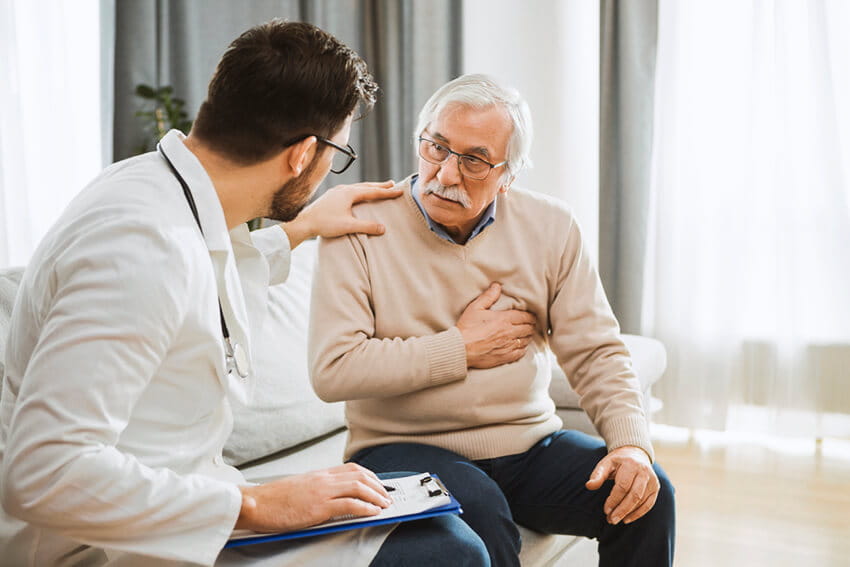Sudden cardiac arrest vs. heart attack

Your heart plays an essential role by pumping blood throughout your entire body. So, it's reasonable to be worried, or even anxious, that something could happen to it. Knowing the common causes and symptoms of a heart attack and/or sudden cardiac arrest can help you have piece of mind and know how to act if you experience concerning symptoms.
While many people may think that a heart attack and sudden cardiac arrest are the same condition, they're not the same at all. Although both are heart-related, there are some key differences. Here's what you should know about them.
What is a heart attack?
A heart attack is essentially a blockage in the "plumbing" of your heart. This can happen when the blood that moves through your arteries gets prevented from getting to your heart muscle.
"The artery's job is to bring oxygen-rich blood to your heart so that it can do its essential work," Matthew A. Goldstein, MD, a cardiac electrophysiologist at Paoli Hospital, part of Main Line Health. "When a buildup of a cholesterol, also called plaque, occurs in an artery, that can cause a sudden blockage."
When your heart doesn't receive enough blood, a part of it starts to die. Heart damage gets worse (larger and more permanent) the longer the artery is blocked, so if you, or someone you know, might be showing signs of a heart attack, call 911 immediately.
Heart attack symptoms include:
- Shortness of breath
- Chest pain
- Feeling nauseous or lightheaded
- Pain or discomfort in the jaw, neck, back, arm or shoulder
Getting treatment right away increases your chances for a full recovery.
How is a heart attack treated?
When you're treated for a heart attack, the goal is to restore blood flow that the blockage stopped. Some ways to repair the damage caused during a heart attack include:
- Having a balloon/stent angioplasty (PCI) procedure to re-widen the artery
- Receiving a medication to help your body break up the clot
- Undergoing surgery which can bypass the blocked artery
What is sudden cardiac arrest?
Unlike a heart attack, which is caused by an artery blockage, cardiac arrest is caused by a problem in the electrical system of your heart. Due to this electrical issue (ventricular tachycardia or fibrillation) the heart stops pumping and instead quivers ineffectively. Blood stops traveling to your brain and other organs. If untreated, cardiac arrest can be fatal.
"Just like with a heart attack, time is of the essence. Being treated immediately dramatically increases your chances of surviving," says Dr. Goldstein. "To a witness, sudden cardiac death will look like a person suddenly passes out, but the person won't wake up."
Treatments can include CPR and need to be followed with application of an automatic external defibrillator (AED). This portable device can save lives by working to get your heart back to normal beating through an electric shock, which can "reset" or "restart" you heart's rhythm. Hands-only CPR on a person in cardiac arrest and rapid use of an ICD can double or even triple their chances of survival.
What happens if you go into sudden cardiac arrest?
When someone goes into cardiac arrest, the first thing to do is call 911 right away. Next, perform CPR until the paramedics and or an AED arrive on the scene.
CPR can be done in two ways — one includes both mouth-to-mouth breathing and chest compressions (movements of pushing down hard on the center of the person's chest), while the other involves just chest compressions. Compression-only CPR is now recommended for adults and teens as it provides uninterrupted blood flow to the body.
"Usually, chest compressions alone are enough to help the blood flowing until paramedics arrive," says Dr. Goldstein. "If you ever need guidance, a 911 operator can walk you through the steps while you're waiting for help."
If there's an automated external defibrillator around, use it too, but even just CPR is a great help. The device will often provide auditory instructions to guide you while it is being used.
An AED works like this:
- Sticky pads are placed on the front and left side of your chest
- These pads/electrodes have sensors that will read your heart's rhythm and send this information back to the defibrillator's computer for analysis
- If needed, the device will instruct you to deliver an electric shock to the heart through the pads. It will also remind you to stop CPR and stay clear of the patient during this part of the process
Practicing these lifesaving techniques and investing in a portable external defibrillator to keep nearby are both good practices. Both can help in an emergency situation when someone is going into cardiac arrest.
Are sudden cardiac arrest and heart attacks connected?
Although cardiac arrest and heart attacks are can be different, the two problems do have a connection.
"When a person has a heart attack, their risk for sudden cardiac arrest increases," says Dr. Goldstein. "Cardiac arrest can sometimes occur during a heart attack or during recovery. But, in fact, most heart attacks don't cause cardiac arrest."
If you're experiencing symptoms of a heart attack, call 911 immediately.
Next steps:
Schedule an appointment with Matthew Goldstein, MD
Learn more about Main Line Health's heart specialists
EKG vs ECG — What’s the difference?
 Content you want, delivered to your inbox
Content you want, delivered to your inbox
Want to get the latest health and wellness articles delivered right to your inbox?
Subscribe to the Well Ahead Newsletter.
